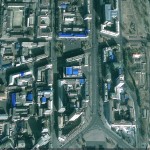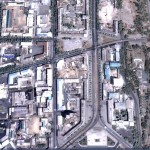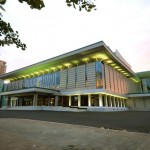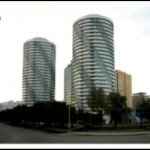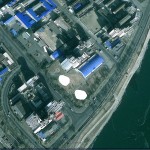In Oct. 2006, a nuclear test was conducted in the remote mountainous area of North Hamgyeong Province, North Korea. This test did not come completely out of the blue. The North Korean government issued an official warning, thus becoming the first nation in history that gave prior notification about a coming nuclear weapons test. This openness might sound strange since we are talking about the world’s most secretive country, but it agrees well with the general character of the North Korean nuclear program. From its inception, the program was largely (but not exclusively) for show, it was aimed at impressing the outside world in order to manipulate it and get what the North Korean leaders wanted to get.
Even though North Korea joined the nuclear club only recently, its nuclear program has long history. It has remained the center of international attention since around 1990, but it began much earlier.
It was the mid-1950s when the first North Korean scientists arrived to work and study in the Joint Institute of Nuclear Research in the Soviet city of Dubna, not far from Moscow. This institution was created by the USSR or former Soviet Union for joint international research in nuclear physics, and until the early 1990s some 250 North Korean scientists underwent training there. Soon afterwards, in 1959 the former Soviet Union and North Korea signed their first agreement on cooperation in nuclear research. A similar agreement was concluded with China as well (Pyongyang never puts all its eggs in one basket!).
In the 1960s, the North Korean version of Los Alamos began to take shape. This role was assigned to the city of Yongbyon, a rather small town, located some 90 kilometers to the north of Pyongyang. It is interesting that, for reasons of greater secrecy, the nuclear research facility was called the “Yongbyon furniture factory.” The major article of infrastructure of this “furniture factory” was not a saw-mill but rather a small Soviet-designed research reactor, completed in 1965. In the 1970s, the North Korean scientists independently modernized the reactor, increasing its output.
There are few doubts that from the very early stages Pyongyang leaders seriously considered the possible military applications of their nuclear research program. But it seems that the North Korean nuclear program made a decisive turn towards military applications in the 1970s. At that time, South Korea was working hard to develop nuclear weapons of its own. For the North, which has always had good intelligence about its arch-enemy, these intentions was hardly a secret, so it seems that around 1975 the North Korean political leaders decided not to lag behind and sped up their own nuclear program.
However, the major obstacle on the path to the acquisition of nuclear weapons was the position of the former Soviet Union. Moscow took non-proliferation seriously, and did everything to control Pyongyang’s nuclear ambitions (incidentally, Washington treated Seoul’s nuclear plans in much the same manner). China also did not want a nuclear power across its border, so the usual North Korean strategy of playing Beijing against Moscow would not work in this case.
The Soviets made their continuing cooperation conditional on full-scale participation in the non-proliferation regime. In exchange for compliance, North Korea was promised technical assistance in building a nuclear power station of its own. Such a station was indeed a good option for a country which heavily depended on imported oil for power generation. Thus, Pyongyang bowed to the Soviet pressure complied and in 1985 signed the Non-Proliferation Treaty while secretly continuing with its nuclear weapons development efforts.
But soon the world changed. The communist bloc that both controlled Pyongyang’s nuclear ambitions and provided it with aid, collapsed around 1990. The foreign aid almost disappeared, and Pyongyang had to survive somehow in an increasingly hostile world.
The North Korean leaders came to a conclusion that in their peculiar situation the Chinese style policy of reforms would be too risky. Indeed, in a divided country, with South doing so much better than the North, attempted reforms were likely to produce German-style collapse, not Chinese-style economic boom. So, in order to keep their power and privileges the North Korean leaders had to avoid any changes in the system. It was a rational choice for them, even though this policy choice condemned hundreds of thousands to death by starvation and completely ruined the already weak economy.
Since the country was stuck with a remarkably inefficient economic system, it could not feed itself, so it badly needed foreign aid ― a lot of it. But the ruling elite, the few hundred families around the Kim’s hereditary dictatorship, also knew that the aid should come without too many conditions attached and, above all, with as little monitoring as possible. They needed food, above all, to feed the privileged and politically significant regions and social groups, leaving others to their sorry fate. Since a riot in the capital would be deadly dangerous for the regime, Pyongyang should be given some food. The police and elite military units should eat well, too, since their loyalty was vital for the stability of the regime. At the same time, the survival of, say, miners at some distant mining town was never a high priority for Pyongyang decision makers.
However, getting large-scale aid without many conditions would be a difficult, almost impossible task had not Pyongyang had in its disposal the already well advanced military nuclear program. From around 1990, the program became the major diplomatic tool which was used with the greatest skill in order to insure the continuous influx of foreign aid.
This is not to say that the nuclear program had no military significance whatsoever ― Pyongyang had some reasons to be afraid of a foreign attack. Pyongyang leaders were correct when they say privately that Hussein would probably still be living in his palace, if Iraq indeed had nuclear weapons. Nonetheless, from the early 1990s the major rationale behind the program has been not military deterrence, but rather diplomatic blackmail.
From around 1990, Pyongyang began to arrange leaks about its nuclear weapons program, while officially denying its existence. It threatened to withdrew from the non-proliferation treaty, and its officials promised to transform Seoul into a “sea of fire” if their demands would not be met.
The strategy worked. In 1994 the strangely named “Agreed Framework” treaty was signed in Geneva. An international consortium where the U.S. and South Korea were major donors, agreed to provide North Korea with light water reactors for power generation (those reactors cannot be used for production of weapon-grade plutonium) and also promised regular shipments of fuel oil. In exchange, North Korea promised to freeze its military nuclear program and accept international inspections of its nuclear facilities. It is widely believed that the U.S. negotiators were ready to give generous concessions because at that time they assumed that the North Korean regime would collapse soon. They were wrong: to the surprise of foreign observers, Kim Jong-il managed to stay in control of his starving country.
The indirect impact of the nuclear program was great as well. In the late 1990s and early 2000s, North Korea got what it needed: a lot of foreign aid without too many monitors. One can doubt whether the amount of aid would have been so large, had North Korean not been seen as a potentially nuclear country.
The so-called “second nuclear crisis” erupted in 2002 when it was discovered that North Koreans were cheating: they were secretly pursuing a uranium enrichment program. This was used as a pretext to the discontinuation of aid. After few years of unsuccessful negotiations, the North Korean diplomats decided to raise the stakes, and in October 2006 the first nuclear test was conducted. It worked: in merely few months, the U.S. agreed to make important concessions and aid was resumed. A new hike in tensions produced a new nuclear test in 2009.
So, by now the nuclear crisis has continued for two decades, and it seems that it might easily continue 25 years. The North Korean government understands that a nuclear weapon is their major diplomatic card, and they are unlikely to surrender it under any circumstances. The outside world is disunited and, frankly, lacks any means to influence Pyongyang. So, we are quite likely to see more nuclear tests (largely successful) and more nuclear negotiations (largely unsuccessful) in the years or even decades to come.

